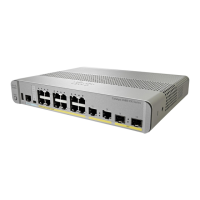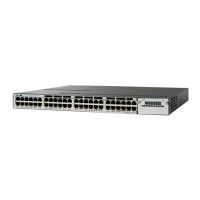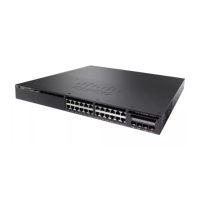because it is possible for an unknown or unexpected source to become active. If no RP is configured to limit
source registration, the group may revert to dense mode operation and be flooded with data.
Related Topics
Adding Auto-RP to an Existing Sparse-Mode Cloud (CLI), on page 149
Auto-RP Benefits
Auto-RP uses IP multicast to automate the distribution of group-to-RP mappings to all Cisco routers and
multilayer devices in a PIM network. Auto-RP has these benefits:
•
Easy to use multiple RPs within a network to serve different group ranges.
•
Provides load splitting among different RPs and arrangement of RPs according to the location of group
participants.
•
Avoids inconsistent, manual RP configurations on every router and multilayer device in a PIM network,
which can cause connectivity problems.
Benefits of Auto-RP in a PIM Network
•
Auto-RP allows any change to the RP designation to be configured only on the devices that are RPs,
not on the leaf routers.
•
Auto-RP offers the ability to scope the RP address within a domain.
PIMv2 Bootstrap Router
PIMv2 Bootstrap Router (BSR) is another method to distribute group-to-RP mapping information to all PIM
routers and multilayer devices in the network. It eliminates the need to manually configure RP information
in every router and device in the network. However, instead of using IP multicast to distribute group-to-RP
mapping information, BSR uses hop-by-hop flooding of special BSR messages to distribute the mapping
information.
The BSR is elected from a set of candidate routers and devices in the domain that have been configured to
function as BSRs. The election mechanism is similar to the root-bridge election mechanism used in bridged
LANs. The BSR election is based on the BSR priority of the device contained in the BSR messages that are
sent hop-by-hop through the network. Each BSR device examines the message and forwards out all interfaces
only the message that has either a higher BSR priority than its BSR priority or the same BSR priority, but
with a higher BSR IP address. Using this method, the BSR is elected.
The elected BSR sends BSR messages with a TTL of 1. Neighboring PIMv2 routers or multilayer devices
receive the BSR message and multicast it out all other interfaces (except the one on which it was received)
with a TTL of 1. In this way, BSR messages travel hop-by-hop throughout the PIM domain. Because BSR
messages contain the IP address of the current BSR, the flooding mechanism enables candidate RPs to
automatically learn which device is the elected BSR.
Candidate RPs send candidate RP advertisements showing the group range for which they are responsible to
the BSR, which stores this information in its local candidate-RP cache. The BSR periodically advertises the
contents of this cache in BSR messages to all other PIM devices in the domain. These messages travel
hop-by-hop through the network to all routers and devices, which store the RP information in the BSR message
IP Multicast Routing Configuration Guide, Cisco IOS XE Release 3.6E (Catalyst 3850 Switches)
OL-32598-01 133
Configuring PIM
Rendezvous Points

